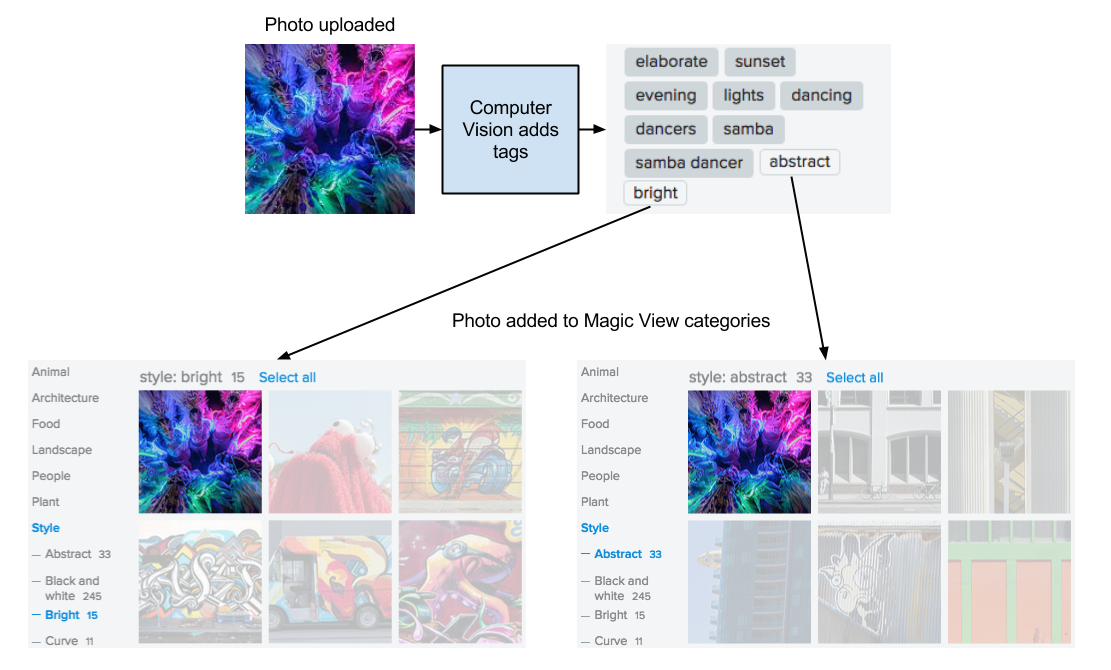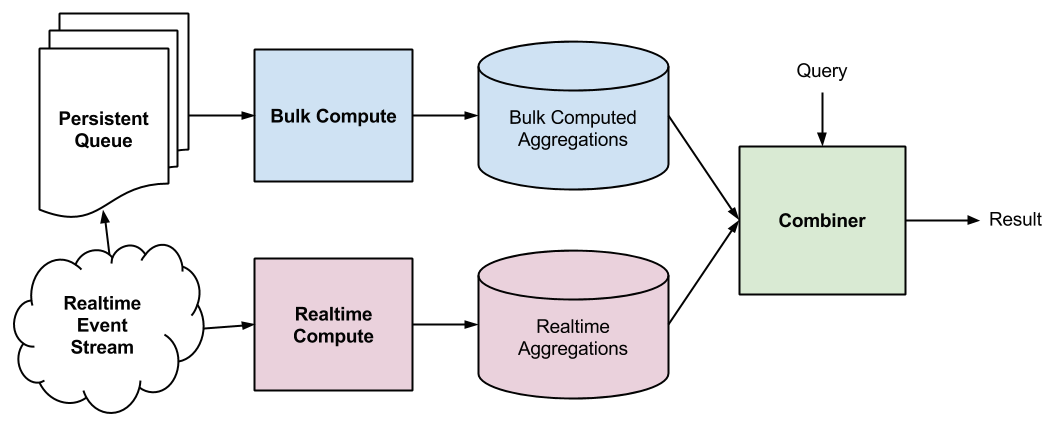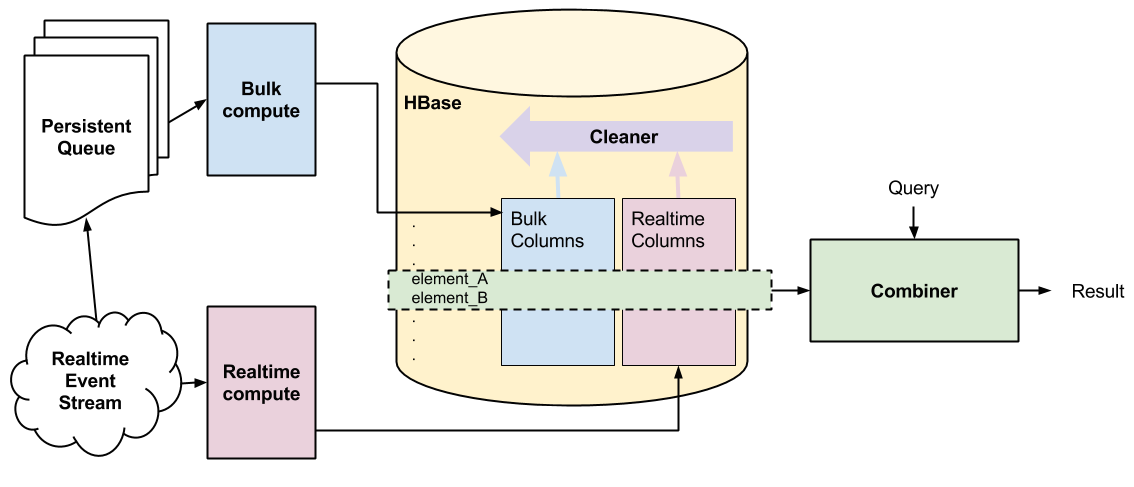YahooArchive / Simplified Lambda
Programming Languages
Simplified Lambda Example
This repository is a working example of Flickr's Simplified Lambda Architecture. The architecture is used to fuse bulk and realtime data for Flickr's Magic View at a gigantic scale using HBase.
Introduction
Flickr’s Magic View takes the hassle out of organizing your own photos by applying our cutting-edge, computer-vision technology to automatically categorize photos in your photostream and present them in a seamless view based on the content in the photos. This all happens in real-time - as soon as a photo is uploaded, it is categorized and placed into the Magic View.
The Challenge
Our computational footprint made it easy to create per-user Magic View categories for over 12 billion images on Flickr; however, we also needed to combine this with updating the categories with the the tens of millions of tags generated from photos as they are uploaded in real-time. Ideally, the system has to allow us to efficiently but separately manage the bulk and real-time data that only computes the final state when requested. We turned to Yahoo’s Hadoop stack to find a way to build this at the massive scale we needed.
Our Solution
Powered by Apache HBase, we developed a new scheme to fuse results from bulk and real-time aggregations. Using a single table in HBase, we are able to independently update and manage the bulk and real-time data in the system while always being able to provide a consistent, correct result.
We believe that this solution is a novel simplification of what is sometimes known as Lambda Architecture. We improve it by simplifying some of its complicated components making maintenance and development easier.
Lambda Architecture
Existing approach
We’ll start with Nathan Marz’s book, ‘Big Data’, which proposes the database concept of ‘Lambda Architecture’. In his analysis, he states that a database query can be represented as a function - Query - which operates on all the data:
result = Query(data)
The core of the Lambda architecture allows for separately maintained real-time and bulk databases. Minimizing the number of sacrifices needed to be made but maintaining the goal of operating on all available data, the equation is now expressed as:
result = Combiner(Query(real-time data) + Query(bulk data))
This equation is shown graphically in the figure above. The real-time and bulk compute subsystem write to independent databases, which could be totally different systems. When dealing with a high volume of realtime data, the operational advantage here can be significant - there’s no need to have the expense of combining it with bulk data every time an event comes in.
Concerns around this approach center on the complicated nature of the Combiner function - there is the developer and systems cost from the need to maintain two separate databases, the differing latencies of querying both sides and then the mechanics of merging the result.
Our Approach
We addressed the complications of the Combiner by instead using a single database to store the real-time and bulk data. A Combiner is still required to compute a final result:
result = Combiner(Query(data))
How was this achieved? We implement our simplified Lambda architecture in HBase by giving each row two sets of columns - real-time and bulk - which are managed independently by the real-time subsystem (Storm and Java) and the bulk compute subsystem (Pig Latin and Oozie). It’s worth noting that FiloDb takes a similar approach - but since we only require the latest version of the data, our implementation is simpler.
The combiner stage is abstracted into a single Java process running on its own hardware which computes on the data in HBase and pushes the photostream tag aggregations to a cache for serving.
The Combiner and Cleaner
When reading a single row of data from HBase, we need to combine the data from the real-time and the bulk columns. If only the bulk or real-time data exists, then selecting the data is obvious. If both bulk and realtime data exists, we always pick real-time. This seems reasonable, but causes a subtle problem.
Let’s say a photos computer vision tags are added via real-time compute - there is no bulk data. Later on, we recompute all available photos using a new version of the computer vision tagging, and load this data (including this photo) via a bulk load. Even though the newer data exists in the bulk column, we can’t get to it because the combiner will only read the real-time column. We solve this by running the Cleaner process on all the data in HBase after we do a bulk load.
The Cleaner simply visits each row and sees if the HBase timestamp for the real-time data is older than the bulk load. If it is, then we delete the real-time data for that row since it’s already captured in the bulk columns. This way the results of the bulk compute aren’t ‘published’ until the cleaner has run.
Acknowledgements
Thanks to the entire Flickr Magic View and team for helping out and to Nathan Marz for kindly reviewing this work.
Running the example
Once you've checked out the repository, you can run the demo using:
mvn package; mvn exec:java -Dexec.mainClass="flickr.SimplifiedLambdaDemo.SimplifiedLambdaDemo"
To run the tests, simply run:
mvn package; mvn test
Worked Example
Let's walk through a specific example that is used in the demo.
Initial table
Lets set up an in-memory simulation of HBase using MockHTable:
MockHTable lambdaTable = new MockHTable("lambdaTable");
lambdaTable.addColumnFamily(new String(SimplifiedLambda.FAMILY));
Then we'll pass it to SimplifiedLambda - our central class which implements our Simplified Lambda architecture - to manage.
SimplifiedLambda simplifiedLambda = new SimplifiedLambda(lambdaTable);
Lets dump the initial state of the table:
System.out.println("\nInitial table:");
System.out.print(simplifiedLambda.dumpTable());
Output:
key bulk realtime combined
........................................
The columns here are: key - the row key bulk - the value in the bulk column realtime - the value in the realtime column combined - the final value that SimplifiedLambda will chose between realtime or bulk
Push bulk rows
Let's push some data to the table via the bulk load mechanism. We have to call the cleaner after every time we run the bulk load to keep the system in a consistent state:
simplifiedLambda.pushBulkEntry("rowA", "bulk");
simplifiedLambda.pushBulkEntry("rowB", "bulk");
simplifiedLambda.pushBulkEntry("rowC", "bulk");
simplifiedLambda.cleaner();
The table now looks like:
key bulk realtime combined
........................................
rowA bulk None bulk
rowB bulk None bulk
rowC bulk None bulk
There's only bulk data available so the combiner only chooses data from the bulk column.
Override rows A,B with realtime
Now lets take rowA and rowB and push realtime data to them:
simplifiedLambda.pushRealtimeEntry("rowA", "rtOvrd");
simplifiedLambda.pushRealtimeEntry("rowB", "rtOvrd");
The table now looks like:
key bulk realtime combined
........................................
rowA bulk rtOvrd rtOvrd
rowB bulk rtOvrd rtOvrd
rowC bulk None bulk
Here for rowA and rowB, there is now realtime data available so the combiner will automatically choose it.
Clean table
For rowA and rowB, we can take the realtime data and 'publish' it to the bulk columns since it overrides the bulk columns:
simplifiedLambda.cleaner();
Now the table state is:
key bulk realtime combined
........................................
rowA rtOvrd None rtOvrd
rowB rtOvrd None rtOvrd
rowC bulk None bulk
This isn't actually necessary after a realtime updates - it's an illlustration of how the cleaner works in this scenario.
Override rows B,C with realtime
Lets do another realtime override, now on rowB and rowC:
simplifiedLambda.pushRealtimeEntry("rowB", "rtOvrd2");
simplifiedLambda.pushRealtimeEntry("rowC", "rtOvrd2");
Now the table looks like:
key bulk realtime combined
........................................
rowA rtOvrd None rtOvrd
rowB rtOvrd rtOvrd2 rtOvrd2
rowC bulk rtOvrd2 rtOvrd2
Again: the realtime columns override the bulk data.
Override rows with bulk:
Lastly, lets push some bulk data after the realtime updates - to rowA and rowB. Since the bulk data is newer than the realtime updates for these rows, the bulk data takes precedence over the realtime data that is there.
simplifiedLambda.pushBulkEntry("rowA", "bulkOvr");
simplifiedLambda.pushBulkEntry("rowB", "bulkOvr");
simplifiedLambda.cleaner();
The result:
key bulk realtime combined
........................................
rowA bulkOvr None bulkOvr
rowB bulkOvr None bulkOvr
rowC rtOvrd2 None rtOvrd2
Copyright and License
Copyright 2015 Yahoo Inc. Licensed under the terms of the Apache 2.0 License See LICENSE.txt file in the project root folder for License terms.



